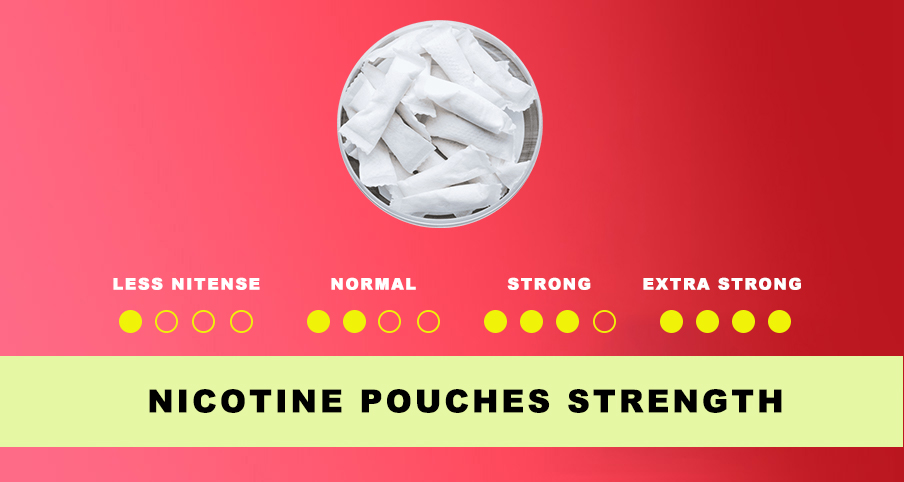
Interpreting the different nicotine strength labels on nicotine pouches is crucial for making an informed choice that suits your personal needs and preferences. Here’s a detailed guide to help you understand these labels and make the right decision.
Nicotine Strength Labels: What They Mean
When browsing for tobacco leaf-free nicotine pouches, you may notice varying labeling systems for nicotine strength. While all nicotine pouches in the U.S. must list the mg nicotine strength on the can, some brands use additional labels such as dots or descriptors like “strong” or “regular.” Here’s what these labels mean:
- Dots on the Can: A strength scale with two or more dots on the front indicates stronger pouches. Generally, regular strength nicotine pouches fall within the range of two dots or less.
- Categories like “Strong” and “Regular”: Some brands use terms such as “strong,” “extra strong,” or “super strong” to describe the overall experience, including factors like the speed of nicotine release and the flavors used. However, these labels do not always explicitly indicate the amount of nicotine present.
Measuring Nicotine Pouch Strength
In the United States, nicotine strength is typically labeled on the can in milligrams per pouch (mg/pouch) as a universal measurement. Some brands may use milligrams per gram (mg/g), which can be confusing. You can convert mg/g to mg per pouch by multiplying the nicotine strength by the net weight of the pouch.
Example: If a pouch has a nicotine strength of 15 mg/g and a net weight of 2 grams, the total amount of nicotine in the pouch would be 30 mg.
Understanding MG
MG stands for milligrams and refers to the amount of nicotine contained in each pouch. The higher the MG, the stronger the pouch.
Typically, nicotine pouch strengths range from 3 mg to 15 mg, with some brands offering even stronger options. The highest nicotine content per pouch available is usually 20 mg, which is the maximum amount recommended for a nicotine pouch. All products are laboratory tested to ensure quality and consistency.
Nicotine Strength Categories
Nicotine strength labels denote the amount of nicotine in each pouch and are categorized as follows:
- Low Strength (1-3 mg/pouch):
- Target Users: Ideal for beginners, light smokers, or those looking to taper off nicotine.
- Experience: Provides a mild nicotine hit, less likely to cause dizziness or discomfort for new users.
- Moderate Strength (4-6 mg/pouch):
- Target Users: Suitable for regular users who smoke moderately.
- Experience: Offers a balanced nicotine effect that is noticeable but not overpowering, perfect for daily use.
- High Strength (7-10 mg/pouch):
- Target Users: Best for experienced users or heavy smokers.
- Experience: Delivers a strong nicotine hit that satisfies the cravings of those accustomed to higher nicotine intake.
- Extra High Strength (11-20 mg/pouch and above):
- Target Users: Aimed at users with a high tolerance or those transitioning from heavy smoking.
- Experience: Provides an intense nicotine hit that can be overwhelming for beginners but meets the needs of long-term heavy users.
Factors Influencing Nicotine Experience
Several factors can influence how you experience the nicotine strength in a pouch:
- Body Chemistry: Individual tolerance levels can vary, so what might be strong for one person could be mild for another.
- Usage Frequency: Regular users often develop a tolerance, requiring higher strengths to achieve the same effect.
- Flavor: Some flavors can enhance or mask the intensity of the nicotine hit. For example:
- Mint and Menthol: Often perceived as stronger due to the cooling sensation.
- Fruity or Sweet Flavors: Can make higher nicotine pouches more palatable by masking the harshness.
- Nicotine Delivery: The formulation of the pouch (e.g., moisture content, pH level) can affect how quickly and intensely nicotine is absorbed.
Tips for Choosing the Right Nicotine Strength
- Assess Your Nicotine Needs:
- Beginner: Start with lower strengths (1-3 mg) to gauge your tolerance.
- Moderate User: Opt for moderate strengths (4-6 mg) if you smoke or use nicotine regularly.
- Experienced User: Choose higher strengths (7-10 mg) if you are accustomed to a significant nicotine intake.
- Heavy User: Consider extra high strengths (11-20 mg and above) if you have a high tolerance or are transitioning from heavy smoking.
- Consider Your Goals:
- Reducing Nicotine Intake: Gradually decrease the strength over time.
- Maintaining Current Levels: Stick with the strength that aligns with your current usage.
- Increased Satisfaction: If current pouches are not satisfying, consider slightly higher strengths.
- Experiment with Flavors:
- Different flavors can change the perception of strength. Experiment with a few to see which ones enhance your experience without increasing the nicotine level unnecessarily.
- Monitor Your Response:
- Pay attention to how your body reacts. If you experience dizziness, nausea, or headaches, it might indicate that the strength is too high.
Nicotine Levels by Brand
To make it easier for you to compare nicotine strengths, we have created a chart that lists the different strengths offered by popular brands like ZYN, Rogue, VELO, and more. See the chart below for a nicotine strength chart for all the brands we currently offer:
| Nicotine Pouch Brands | Number of Nicotine Strength Options | Lowest mg Nicotine Pouches | Highest mg Nicotine Pouches |
| ZYN | 2 | 3mg | 6mg |
| On! | 3 | 2mg | 8mg |
| VELO | 2 | 4mg | 7mg |
| Rogue | 2 | 3mg | 6mg |
| Juice Head | 2 | 6mg | 12mg |
| Lucy | 3 | 4mg | 12mg |
| Sesh+ | 3 | 4mg | 8mg |
| FRE | 3 | 9mg | 15mg |
| zone | 2 | 6mg | 9mg |
| NIC-S | 3 | 3mg | 9mg |
Conclusion
Interpreting nicotine strength labels correctly helps you choose the right product that fits your nicotine needs and preferences. Always start with a lower strength if you are unsure and adjust based on your body’s response and desired experience. Remember that flavors can play a significant role in how you perceive the nicotine strength, so don’t hesitate to try different options to find your ideal match.


